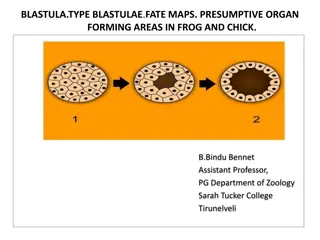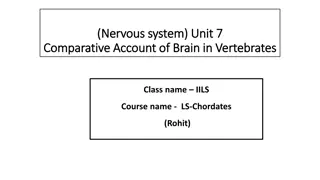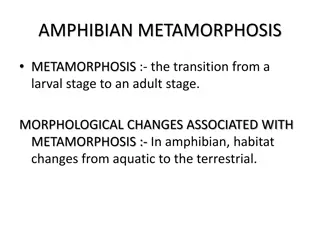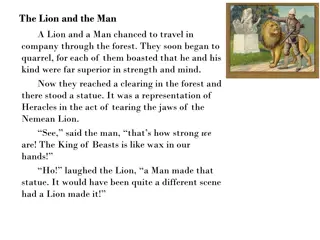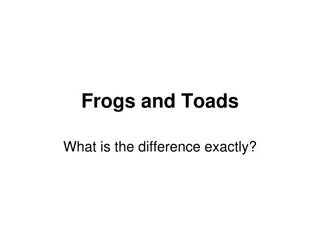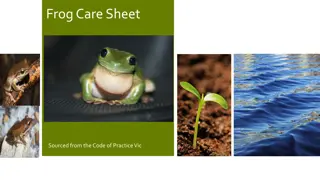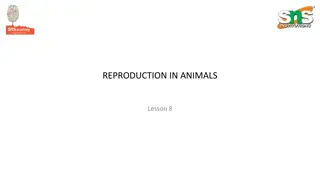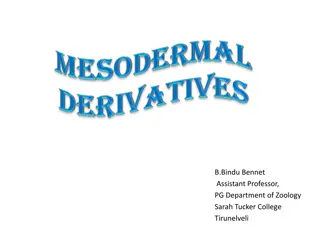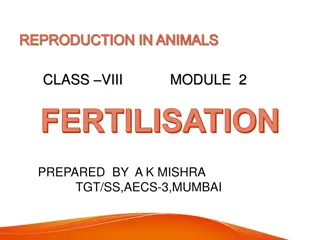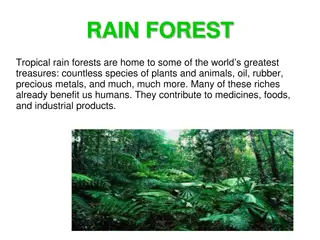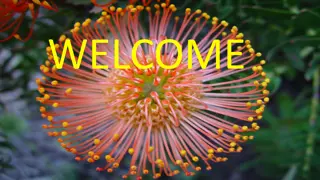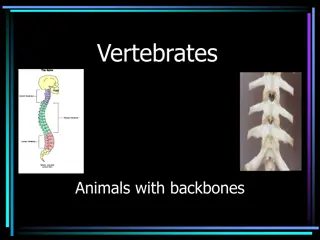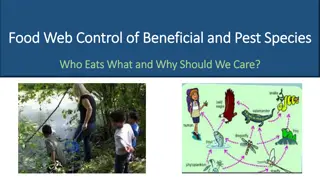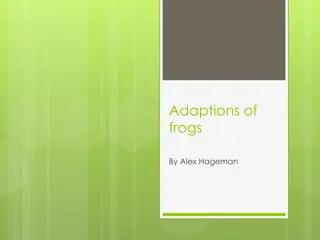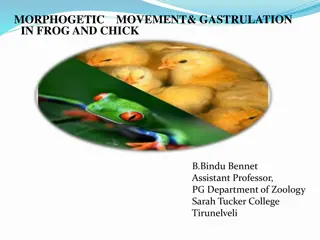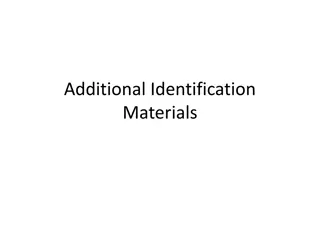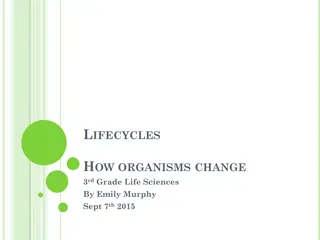Types of Blastulae and Their Formation in Frog and Chick Embryos
The development of blastula, an important stage in embryonic development, gives rise to various types such as coeloblastula, discoblastula, and blastocyst in different animal species. In frogs and birds, varied forms of blastulae are observed based on the amount of yolk present, leading to distinct
1 views • 21 slides
Comparative Analysis of Vertebrate Brains: From Cartilaginous Fish to Amphibians
The brain in vertebrates varies in size and complexity, with distinct structures like the prosencephalon and mesencephalon. From cartilaginous fishes with large olfactory lobes to bony fishes with specialized brains, the evolution of brain structures can be observed. Amphibians, like frogs, show uni
1 views • 12 slides
Amphibian Metamorphosis: A Dive into Developmental Changes
Amphibian metamorphosis marks the transition from larval aquatic life to adult terrestrial existence. The process involves morphological transformations including tail resorption, gill destruction, and skin structure changes. Key changes in urodeles (salamanders) and anurans (frogs/toads) are outlin
1 views • 6 slides
Fables of Aesop: Stories with Timeless Morals
A compilation of classic Aesop's fables including "The Lion and the Man," "The Fox and the Leopard," "The Ants and the Grasshopper," "The Boys and the Frogs," and "The Lion and the Mouse." These stories reflect on themes of pride, wisdom, hard work, and compassion through vivid animal characters and
1 views • 8 slides
A Comparison of Human and Frog Anatomy and Physiology
Humans and frogs share many similarities in their organ systems such as lungs, digestive, circulatory, skeletal, and muscular systems. However, there are also significant differences in body configuration, respiratory system, skeletal structure, and reproductive system. Frogs have unique features li
0 views • 7 slides
Differences Between Frogs and Toads: Explained with Images
Frogs and toads belong to the Amphibia class but have distinct characteristics. Frogs are known for their bulging eyes and smooth skin, while toads are recognized by their warty, dry skin. Despite similarities in life cycles, specific features differentiate the two. Both can be found worldwide, exce
0 views • 16 slides
Reproductive Strategies in Frogs and Hydra: A Comparative Analysis
Frogs and hydra exhibit unique reproductive strategies. Frogs rely on sexual reproduction, lay hundreds to thousands of eggs, and use calls to attract mates, while hydra employ both sexual and asexual reproduction, producing one offspring at a time or through budding. Each strategy presents advantag
0 views • 6 slides
Frog Care Guidelines and Licensing Information in Victoria
Understanding the regulations around caring for frogs in Victoria is crucial. Frogs are amphibians that require a license for captivity, with specific species listed for licensed and unlicensed ownership. Providing a stress-free environment and considering the long lifespan of some species are essen
0 views • 6 slides
Understanding Animal Reproduction: Key Concepts and Life Cycles
Exploring the fascinating world of animal reproduction, this lesson covers the basics of how animals produce offspring, including the parts of an egg, differences between tadpoles and adult frogs, stages in the life cycle of a cockroach, and distinctions between larvae and nymphs. It also delves int
0 views • 10 slides
Murrumbidgee Monitoring and Research Update - January 2020
Monitoring and evaluation of fish, frogs, tadpoles, water quality, and vegetation diversity were conducted at various sites in the Murrumbidgee region in January 2020. Wetland surveys indicated varied status at different sites, with detailed observations on environmental water levels. High numbers o
0 views • 18 slides
Development of Extraembryonic Membranes in Frog Embryos
The developmental stages of extraembryonic membranes in frog embryos are visually illustrated in a series of images. These images showcase the intricate processes involved in the formation of structures such as the amnion, chorion, yolk sac, and allantois, leading up to the development of the placen
0 views • 18 slides
The Tale of Six Green and Speckled Frogs
Follow the fun adventures of six green and speckled frogs sitting on a log, jumping into a pool one by one, and enjoying delicious bugs. As they splash into the pool, their numbers decrease, leading to heartwarming moments. The story of the lively frogs captures the joy of nature's simple pleasures.
0 views • 7 slides
Explore Baby Animal Growth with Worksheets
Discover how baby animals grow and change through engaging worksheets in this PowerPoint presentation. From tadpoles evolving into frogs to baby birds developing into flying adults, learn about the fascinating life cycles of various creatures in nature.
0 views • 5 slides
Understanding Fertilisation and Embryo Development in Animals
The process of reproduction in animals involves the crucial step of fertilisation, where a sperm fuses with an egg to form a zygote. There are two main types of fertilisation - internal and external. Internal fertilisation occurs within the female body, as seen in humans, cows, and other animals. On
0 views • 16 slides
The Marvels of Tropical Rainforests: Riches, Wildlife, and Conservation
Tropical rainforests are abundant with treasures like diverse plant and animal species, resources such as oil and rubber, and essential contributions to medicine and industry. This ecosystem also hosts unique animals like poison arrow frogs, toucans, and sloths, along with fascinating plants like br
0 views • 7 slides
English Lesson: Fazle and Saiful's Adventure by the Pond
In this English lesson for Class Three students, teacher Md. Manik Hossain introduces the story of Fazle and Saiful playing near a pond. The lesson focuses on listening and reading simple stories, with learning outcomes aimed at understanding and enjoying narratives. The class engages in activities
0 views • 19 slides
Discover the Fascinating World of the Rainforest with Ms. Gladman
Journey through the diverse layers of the rainforest and explore the unique habitats of animals like turtles, snakes, jaguars, red-eyed tree frogs, chimpanzees, and butterflies. Learn about the forest floor, understory, canopy, and emergent layers that make up this rich ecosystem all over the world.
0 views • 15 slides
Exploring Vertebrates: Skeletons and X-rays
Dive into the world of vertebrates with a detailed exploration of their skeletons and X-rays. Discover the fascinating structures of frogs, snakes, lizards, birds, fish, humans, bats, dogs, dolphins, and even dinosaur fossils. Explore the intricate details through a series of captivating images, she
0 views • 18 slides
Fun English Lesson for Grade Five Students
Join Assistant Teacher Md. Azim Uddin in an engaging English lesson about animal sounds. Explore why frogs croak, enjoy group activities, learn new words, and participate in a fun evaluation. Don't forget to revise the text as homework!
0 views • 11 slides
Understanding Food Webs in Aquatic Habitats
Exploring the intricate relationships within aquatic food webs, this content delves into the control of beneficial and pest species, highlighting the importance of biodiversity and the factors that influence species presence and success. From the role of frogs in the ecosystem to the impact on tadpo
1 views • 6 slides
Fascinating Facts About Frog Adaptations
Learn about the unique adaptations of frogs, including their carnivorous diet, skin functions, climbing abilities, big eyes for survival, impressive jumping skills, preferred habitats, and the differences between frogs and toads.
0 views • 10 slides
Gastrulation Process in Frog and Chick Embryos
Gastrulation is a crucial stage in embryo development where the blastula transforms into a gastrula, involving the formation of the archenteron and primitive germ layers. Morphogenetic movements play a key role in this process, leading to the reorganization of cells. In frogs, gastrulation involves
0 views • 21 slides
Hush! Shared Reading Week 4 - Minfong Ho
Hush! is a delightful children's book by Minfong Ho with charming illustrations by Holly Meade. The story unfolds in a rhythmic pattern as various animals make noise near a sleeping baby, prompting a hushing response to keep the baby sleeping peacefully. The delightful interactions with black cats,
0 views • 5 slides
Collection of Wildlife Identification Images
Explore a diverse collection of images showcasing various wildlife identification materials such as tracks, wings, and species like wild turkeys, alligators, frogs, and snakes. From unique patterns to distinctive features, these images offer insight into the characteristics of different animals in t
0 views • 31 slides
Understanding Organism Changes in their Lifecycles
Explore how organisms such as butterflies and frogs undergo significant changes from birth to adulthood in their lifecycles. Learn about traits, survival mechanisms, and environmental adaptations. Discover ways to protect Monarch Butterflies and engage in interactive educational games to deepen unde
1 views • 7 slides
